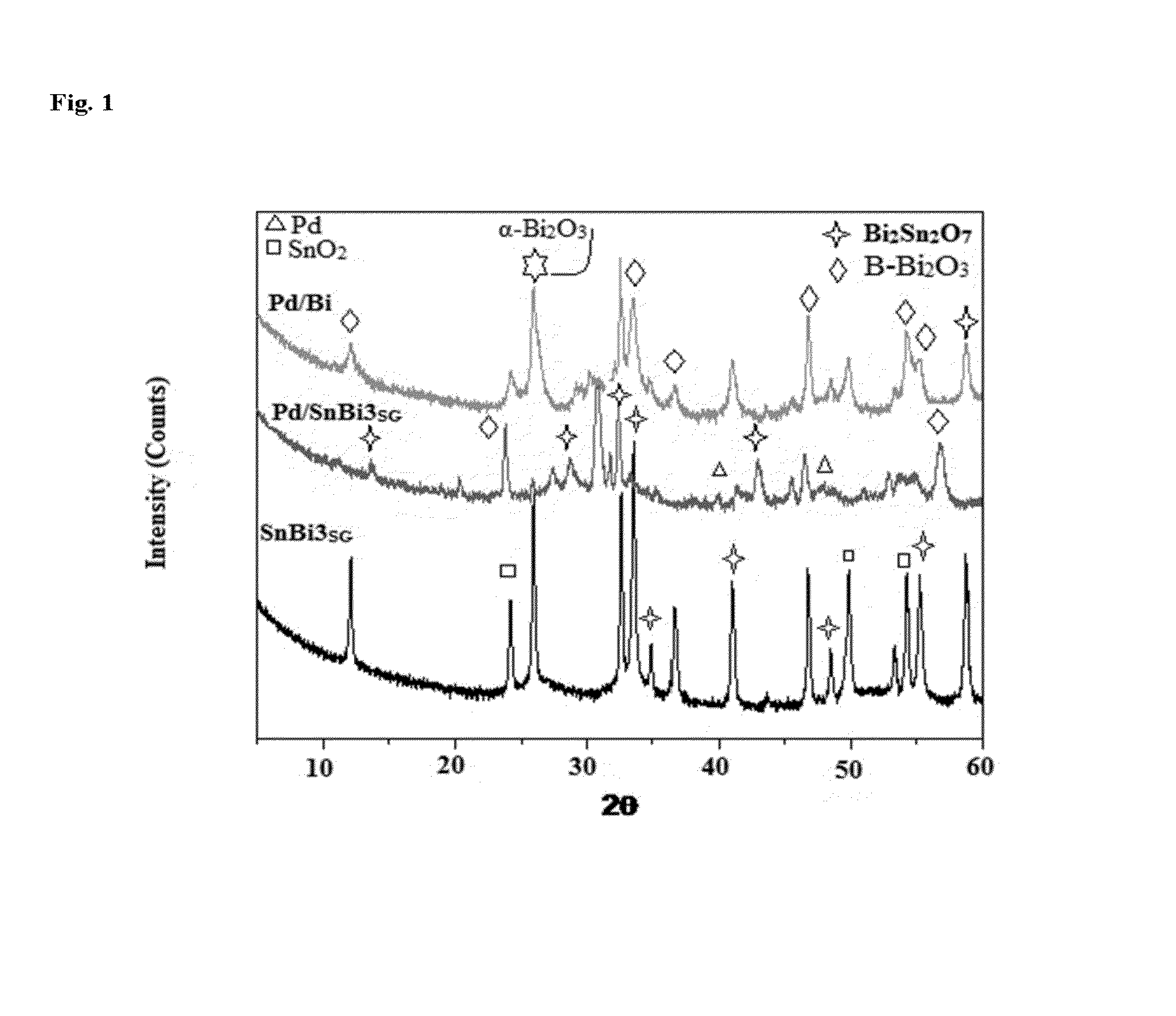Metal oxide supported palladium catalyst for hydrocarbon oxidation
a technology of hydrocarbon oxidation and metal oxide, which is applied in the direction of catalyst activation/preparation, metal/metal-oxide/metal-hydroxide catalyst, physical/chemical process catalyst, etc., can solve the problems of slow process kinetics and therefore unsatisfactory, and achieves reduced power, increased band gap, and low activity
- Summary
- Abstract
- Description
- Claims
- Application Information
AI Technical Summary
Benefits of technology
Problems solved by technology
Method used
Image
Examples
example 1
Synthesis of Pd / SnO2—Bi2O3 Nanostuctures
[0081]All chemicals were analytical grade and used without further purification. In a typical procedure, appropriate amounts of Bi(NO3)3.5H2O and Sn(NO3)4 were used so as to obtain a 3:1 atomic ratio in the final product. Bi(NO3)3.5H2O was first dissolved in water containing polyethylene glycol-2000 [(HO(CH2CH2O)nH)-PEG 2000-2 g / 100 ml water)] (100 ml) and same for Sn(NO3)4. Sn(NO3)4 solution was poured onto the Bi(NO3)3.5H2O solution under vigorous stirring. Ammonia solution (15%) was then added into the mixed solution in a drop wise manner until precipitation takes place and thus the reacting solutions were kept at 85° C. under vigorous stirring until a gel was formed. Then, the gel was transferred into a Teflon-lined stainless autoclave (300 mL capacity) at the temperature of 140° C. for 24 h via incubation in an electric oven. The system was then cooled to ambient temperature naturally. The as-prepared sample was collected and washed with ...
example 2
Synthesis of Pd / Bi2O3 Nanostructures
[0082]In a typical procedure, a stoichiometric amount of Bi(NO3)3.5H2O was dissolved in 100 ml of distilled water containing polyethylene glycol-2000. The pH was adjusted to a value of 8.8 via drop-wise addition of ammonia solution (15%, v / v) was performed until complete precipitation. After gelation for 24 h in a Teflon lined autoclave at 140° C., the gel was then filtered, washed with distilled water for several times and dried at 110° C. overnight. Finally, the sample was calcined at 500° C. for 6 h. To a portion of the calcined sample, an adequate amount of Pd(NO3)2 solution; so as to form a loading of 2% Pd, was added. Subsequently, vigorous stirring was achieved followed by drop-wise addition of PEG-6000 at a concentration of 3 g / 100 ml. Calcinations at 500° C. for 6 h was accomplished following filtering, washing and drying at 110° C. This sample was denoted as Pd / BiSG.
example 3
X-Ray Diffraction (XRD)
[0083]The X-ray powder diffraction patterns of various solids were carried out using a Philips 321 / 00 instrument. The patterns were run with Ni-filtered Cu Kα radiation (λ, =1.541 Å) at 36 kV and 16 mA with scanning speed of 2° in 2θ min−1. The XRD phases present in the samples were identified with the help of ASTM powder data files.
PUM
| Property | Measurement | Unit |
|---|---|---|
| size | aaaaa | aaaaa |
| specific surface area | aaaaa | aaaaa |
| weight | aaaaa | aaaaa |
Abstract
Description
Claims
Application Information
 Login to View More
Login to View More - R&D
- Intellectual Property
- Life Sciences
- Materials
- Tech Scout
- Unparalleled Data Quality
- Higher Quality Content
- 60% Fewer Hallucinations
Browse by: Latest US Patents, China's latest patents, Technical Efficacy Thesaurus, Application Domain, Technology Topic, Popular Technical Reports.
© 2025 PatSnap. All rights reserved.Legal|Privacy policy|Modern Slavery Act Transparency Statement|Sitemap|About US| Contact US: help@patsnap.com



